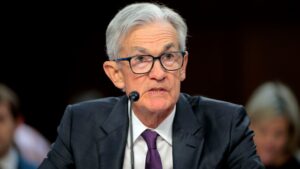Understanding the Economic Landscape: Key Insights from the Latest CNBC Fed Survey
As we navigate the complexities of the U.S. economy, the insights from the March CNBC Fed Survey serve as crucial indicators of investor sentiment and economic outlook. With Federal Reserve Chair Jerome Powell recently testifying before the Senate Banking Committee, the financial landscape is ripe for examination. At Extreme Investor Network, we believe it’s our responsibility to keep our readers informed and prepared to make savvy investment decisions.
Rising Recession Fears
The March survey reveals a significant shift in expectations, with the probability of a recession climbing to 36%, up from January’s 23%—a stark reflection of the current economic climate. This spike in recession unease is the highest seen in six months and points to heightened concerns surrounding the fiscal policies influenced by the Trump administration. Surprisingly, tariffs have emerged as the leading threat to the U.S. economy, overtaking inflation as the primary concern for many analysts and fund managers surveyed.
The implications for the S&P 500 aren’t promising, either; the outlook has taken a downturn for the first time since September, indicating a potential shift in investor confidence. As our readers, you must stay attuned to these indicators, as they can inform your investment strategies going forward.
Key Takeaway: Monitor Tariff Impacts
Given that 70% of respondents consider tariffs as detrimental to inflation, jobs, and overall economic growth, it’s essential to keep close tabs on trade policy changes. As an investor, understanding how these dynamics interact can help you position your portfolio more effectively.
Adjusted Growth Forecasts
The average GDP growth forecast for 2025 has also seen a notable decline—from 2.4% to 1.7%. This halved projection marks the end of a series of optimistic increases started in September. While a rebound is projected for 2026, reaching 2.1%, investors need to be wary of the current headwinds. Neil Dutta from Renaissance Macro Research notes the delicate balance of consumer spending, suggesting numerous variables—including a stagnating housing market—that may skew growth estimates further downward.
Strategy Tip: Explore Defensive Investments
Given the downward revisions in GDP forecasts, consider incorporating defensive stocks into your portfolio. These are typically more resilient during economic downturns and can serve as a protective buffer against market volatility.
The Fed’s Dilemma: Rate Cuts Ahead?
Looking to monetary policy, there’s consensus among survey respondents that the Federal Reserve may be compelled to cut interest rates, with three-quarters suggesting that at least two rate cuts are imminent this year. Yet, the outlook remains clouded by uncertainty: 19% believe the Fed won’t cut rates at all. This disparity reflects the broader unpredictability stemming from fiscal policies, particularly regarding tariffs.
Insight: Timing is Everything
Effective investment decisions often hinge on the timing of market reactions to policy changes. Those tuned into the Fed’s communications and economic indicators will be better equipped to navigate this uncertainty.
Navigating Tariff Implications
The specter of tariffs looms large, with over 70% of survey participants anticipating detrimental effects on inflation and jobs. Nearly one-third believe that tariffs will reduce U.S. manufacturing outputs. As recent shifts in trade policy suggest, the delicate interplay of tariffs could disrupt recovery efforts just as the economy appears to gain traction.
Actionable Advice: Diversify Your Exposure
As tariffs become a more pressing concern, diversifying your investments—especially in sectors known to be affected by trade—could mitigate risks. Explore industries that thrive in both robust and weakened economic conditions, such as utilities or consumer staples.
Conclusion: Stay Informed, Stay Ahead
In these turbulent times, keeping a finger on the pulse of economic indicators and expert analyses is critical for informed investing. As we observe the unfolding drama of economic policies and their repercussions, remember that being proactive rather than reactive can set you apart as an investor. Stay connected with Extreme Investor Network for ongoing insights that empower your investment decisions and allow you to thrive even amid economic uncertainty.
By approaching the current financial landscape with a strategic mindset and leveraging data-driven insights, you can navigate these tumultuous waters and ultimately secure your investment objectives.

